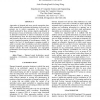Free Online Productivity Tools
i2Speak
i2Symbol
i2OCR
iTex2Img
iWeb2Print
iWeb2Shot
i2Type
iPdf2Split
iPdf2Merge
i2Bopomofo
i2Arabic
i2Style
i2Image
i2PDF
iLatex2Rtf
Sci2ools
64
Voted
ICASSP
2009
IEEE
2009
IEEE
On the role of localization cues in binaural segregation of reverberant speech
Approaches to binaural and stereo speech segregation have often assumed that localization information can be used as a primary cue to achieve segregation of a target signal. Results produced by these systems degrade significantly in the presence of room reverberation. In this work, we present an alternative framework to achieve localization of groups of time-frequency units. We show that grouping across time and frequency allows the use of localization as an important cue for sequential grouping of time-frequency objects. We analyze the level of time-frequency grouping needed to achieve accurate object localization and show preliminary binaural segregation results using the proposed framework. Results indicate that both localization and segregation performance can be improved by grouping across time and frequency.
ICASSP 2009 | Localization Information | Preliminary Binaural Segregation | Signal Processing | Stereo Speech Segregation |
Related Content
| Added | 21 May 2010 |
| Updated | 21 May 2010 |
| Type | Conference |
| Year | 2009 |
| Where | ICASSP |
| Authors | John Woodruff, DeLiang Wang |
Comments (0)

